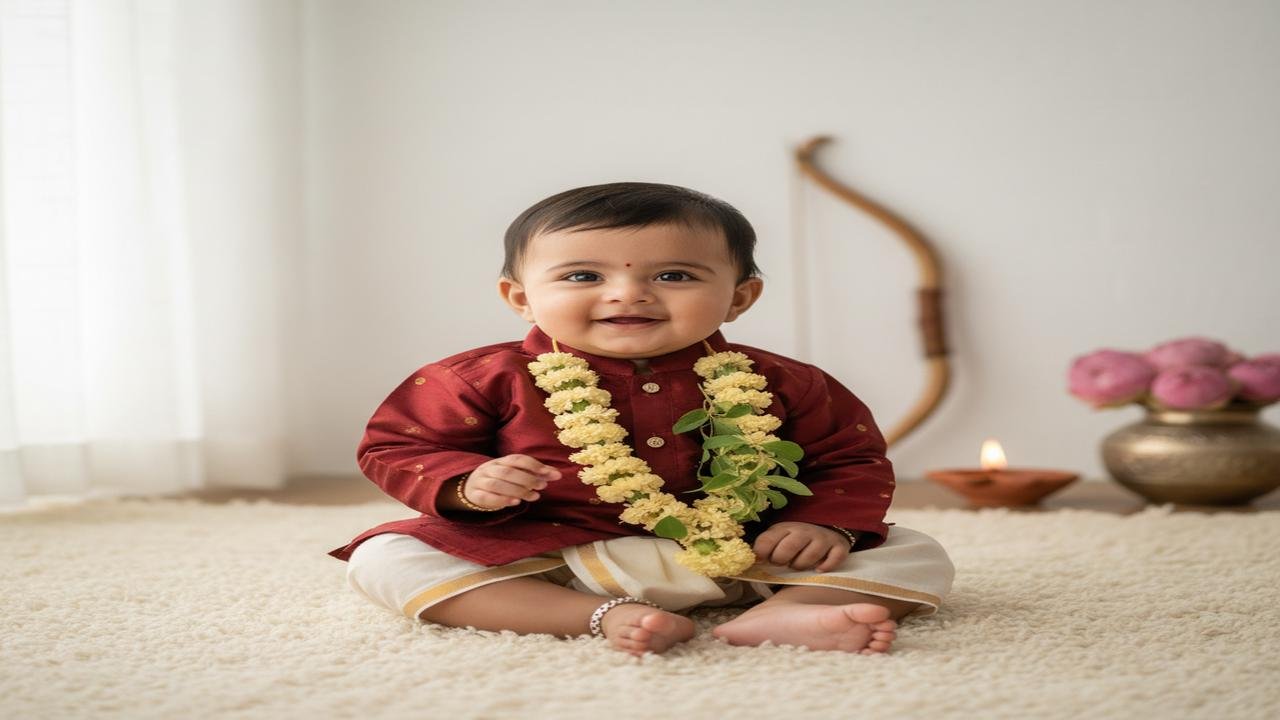Top 10 Hindu Baby Names Inspired by Lord Rama and Sita

Introduction
Names drawn from the stories of Lord Rama and Sita carry layered meanings: family lineage, moral ideals, regional identity and devotional feeling. In Sanskrit, dharma — ethical duty — is a recurring theme in the Ramayana, and many names inspired by Rama and Sita evoke that framework. Below are ten well-rooted options (five commonly used for boys, five for girls), each with meaning, scriptural or traditional context, pronunciation tips and regional variants. I note interpretive differences where relevant: different communities emphasise different episodes and qualities, and that variety is part of living Hindu traditions.
How to use this list
- Think about meaning and sound together: the same root can have several spellings (Rama, Ram, Ramachandra) and different regional pronunciations.
- Consider family and community practice: many families perform a namakarana — naming ceremony — guided by elders or priests; practices vary by region and tradition.
- If you plan a religious observance (for example celebrating Rama Navami), note that such fasts or rituals can affect health; consult family elders or a medical professional if you have concerns.
Top 10 names inspired by Lord Rama and Sita
-
Rama / Ram (male)
Meaning: “the pleasing one” or “one who brings joy.” Pronounced RAH-ma or ram in fast speech.
Context: The central figure of the Valmiki Ramayana (the Sanskrit epic usually dated to the early 1st millennium BCE through later layers). Rama is widely revered across Vaiṣṇava, Smārta and other traditions as an exemplar of dharma.
Notes: Universally recognisable; easy to pair as a short name or as part of compounds (e.g., Ram Prasad).
-
Ramachandra (male)
Meaning: “Rama who is like the moon” (Rama + Chandra — moon). Pronounced RAH-mah-CHAN-dra.
Context: A venerative epithet found in Ramayana retellings and Puranic lists; emphasises Rama’s gentle, luminous qualities.
Notes: Formal and classical; often shortened to Ram or Chandra in daily use.
-
Raghav / Raghava (male)
Meaning: “descendant of Raghu” — Raghu was a celebrated ancestor in the Solar dynasty (Raghuvamsha). Pronounced RAG-hav / Ra-gha-va.
Context: Frequently appears in the Ramcharitmanas (Tulsidas) and classical Sanskrit poetry as an epithet of Rama, underscoring dynastic identity.
Notes: Slightly literary feel; common in North India and used across languages.
-
Raghunath (male)
Meaning: “Lord of the Raghu family.” Pronounced RAG-hu-nath.
Context: Another traditional epithet, used as a devotional name for Rama in temples, bhajans and liturgy.
Notes: Grand-sounding and devotional; often shortened to Nath or Raghu by friends and family.
-
Raman (male)
Meaning: Derived from the same verbal root as Rama — “one who delights” or “one who rejoices.” Pronounced RAH-man.
Context: Popular in South India and across modern India; can be both secular and devotional in tone.
Notes: Easy to use across languages; short nicknames include Ram and Manu.
-
Sita (female)
Meaning: Literally “furrow” (she was found in a furrow), and more broadly evokes steadfastness and purity. Pronounced SEE-ta or SEE-taa.
Context: Principal female figure of the Ramayana, daughter of King Janaka of Videha. Different traditions highlight her qualities differently: some emphasise loyalty and endurance, others her agency and moral insight.
Notes: A classic name with strong literary and devotional resonance.
-
Janaki (female)
Meaning: “Daughter of Janaka.” Pronounced JAH-na-kee.
Context: A common epithet used in Sanskrit and vernacular literature to refer to Sita; suggests identity tied to the kingdom of Mithila.
Notes: Slightly formal; variants include Janaki Amma (in South India) as an affectionate form.
-
Vaidehi (female)
Meaning: “Princess of Videha” (the ancient region where Janaka ruled). Pronounced VAI-deh-hee.
Context: A respectful and literary name for Sita found in many classical compositions.
Notes: Elegant and less common, used widely in Bengal, Maharashtra and South India with slight pronunciation shifts.
-
Maithili (female)
Meaning: “of Mithila” — a regional identifier linking Sita to her birthplace. Pronounced MY-thee-lee or MY-thi-li.
Context: Used in poetry and modern usage to emphasise cultural roots; common as a contemporary, culturally grounded name.
Notes: Pleasant for families who wish to highlight regional heritage.
-
Siya (female)
Meaning: A modern Hindi/vernacular variant of Sita; often used colloquially and in contemporary naming. Pronounced SEE-ya.
Context: Popular in contemporary India as a softer, affectionate form.
Notes: Short, modern-feeling and easy to pair with middle or family names.
Practical tips and cultural notes
- Pronunciation: confirm the preferred regional pronunciation early — vowels and retroflex consonants vary across languages.
- Spellings: romanised spellings differ (Sita, Seeta, Siya); pick one that matches official documents to avoid later inconsistencies.
- Interpretive range: scholarship and devotional writings differ in how they interpret Rama’s and Sita’s actions; choosing a name need not imply adherence to one reading.
- Legal and social practicalities: consider how the name flows with your family name and given initials; check local forms for allowed characters.
These names connect to a deep narrative tradition and are used across India in many languages. Whether you choose a classical epithet like Ramachandra or a contemporary form like Siya, the best choice balances meaning, sound, family practice and personal resonance.
